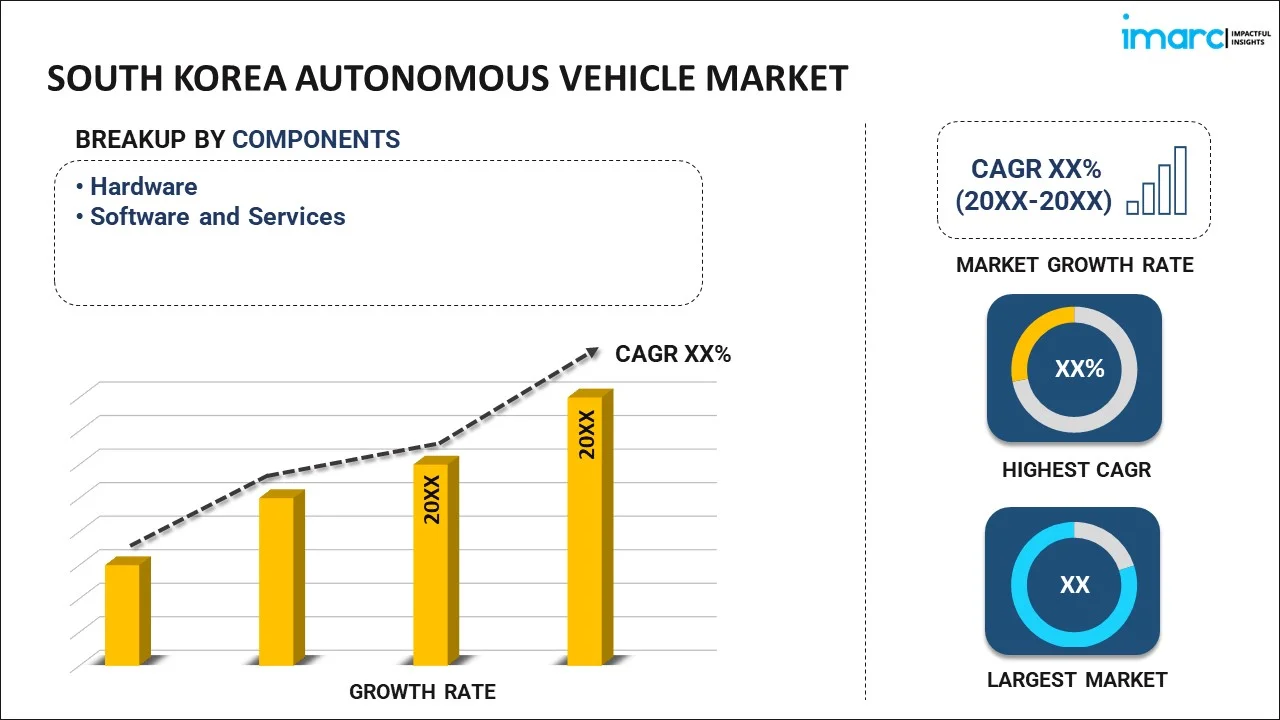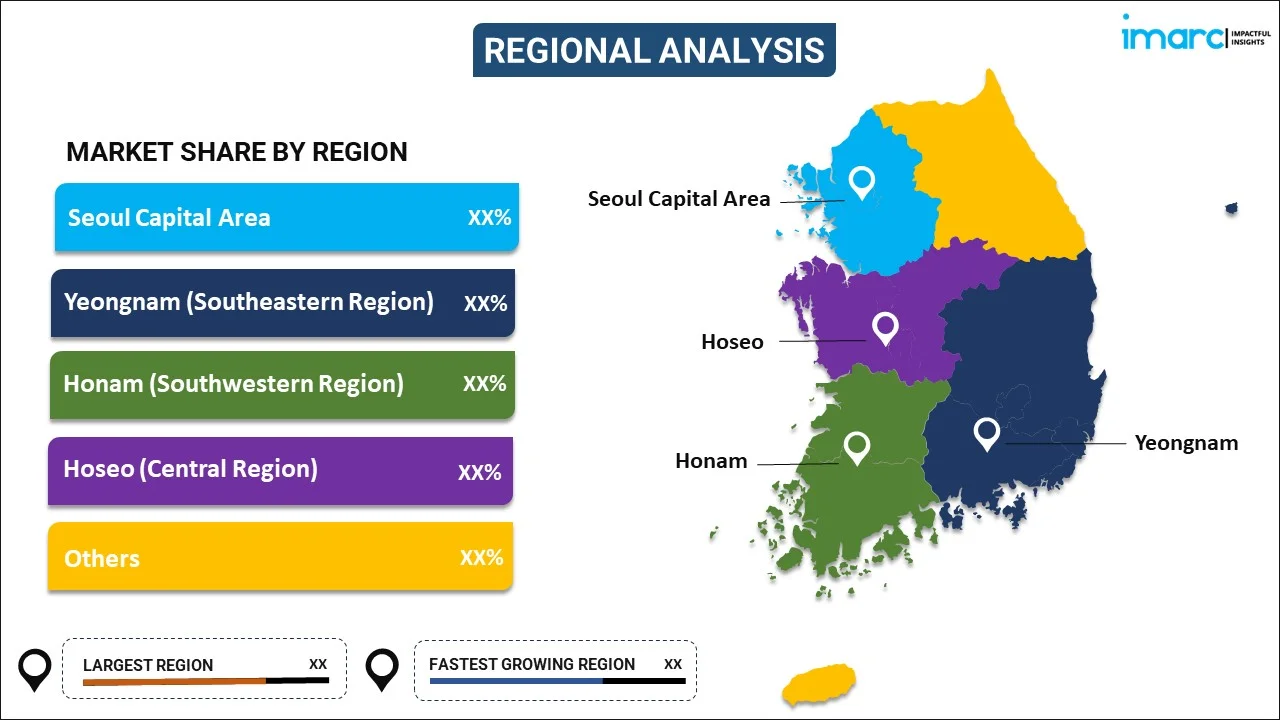
South Korea Autonomous Vehicle Market Report by Component (Hardware, Software and Services), Level of Automation (Level 3, Level 4, Level 5), Application (Transportation and Logistics, Military and Defense), and Region 2025-2033
Market Overview:
South Korea autonomous vehicle market size reached USD 1.5 Billion in 2024. Looking forward, IMARC Group expects the market to reach USD 17.0 Billion by 2033, exhibiting a growth rate (CAGR) of 31.4% during 2025-2033. Numerous advancements in transportation, safety, and sustainability by key players while contributing to the nation's reputation as a tech-forward and innovative society are primarily augmenting the market growth across the country.
|
Report Attribute
|
Key Statistics
|
|---|---|
|
Base Year
|
2024 |
|
Forecast Years
|
2025-2033 |
|
Historical Years
|
2019-2024
|
| Market Size in 2024 | USD 1.5 Billion |
| Market Forecast in 2033 | USD 17.0 Billion |
| Market Growth Rate (2025-2033) | 31.4% |
Referred to as a driverless vehicle, an autonomous vehicle (AV) is capable of functioning independently without human intervention. Its operation relies on a combination of sensors, cameras, and an advanced driver assistance system (ADAS) to perceive its surroundings and make navigation decisions. The primary objective of AV technology is to enhance road safety by preventing collisions and reducing the likelihood of accidents. Additionally, it contributes to the reduction of traffic congestion and the improvement of traffic flow through communication with other vehicles and route optimization. The adoption of AV technology plays a crucial role in minimizing the environmental impact of transportation, leading to faster travel times and decreased fuel consumption. Currently, AV is gaining prominence for its ability to boost productivity, enabling passengers to engage in work, relaxation, and other activities while in transit.
South Korea Autonomous Vehicle Market Trends:
The South Korea autonomous vehicle market stands at the forefront of innovative transportation solutions, showcasing a transformative shift towards driverless technology. One of the primary drivers behind the adoption of autonomous vehicles in South Korea is the commitment to improving road safety. Additionally, through seamless communication with other vehicles and optimized route planning, autonomous vehicles contribute to smoother traffic flow, minimizing delays and improving overall transportation efficiency. Moreover, the South Korea autonomous vehicle market aligns with sustainability goals. AVs are designed to enhance environmental impact by optimizing fuel consumption and reducing emissions. This not only supports the nation's commitment to eco-friendly initiatives but also positions autonomous technology as a key player in the evolution towards greener transportation. Apart from this, the widespread adoption of autonomous vehicles in South Korea is also motivated by the potential for increased productivity during travel. Passengers can utilize their travel time for work, relaxation, or other activities, transforming the commuting experience. As South Korea continues to invest in and embrace autonomous vehicle technology, the market is poised for significant growth over the forecasted period.
South Korea Autonomous Vehicle Market Segmentation:
IMARC Group provides an analysis of the key trends in each segment of the market, along with forecasts at country level for 2025-2033. Our report has categorized the market based on component, level of automation, and application.
Component Insights:

- Hardware
- Software and Services
The report has provided a detailed breakup and analysis of the market based on the component. This includes hardware and software and services.
Level of Automation Insights:
- Level 3
- Level 4
- Level 5
A detailed breakup and analysis of the market based on the level of automation have also been provided in the report. This includes level 3, level 4, and level 5.
Application Insights:
- Transportation and Logistics
- Military and Defense
The report has provided a detailed breakup and analysis of the market based on the application. This includes transportation and logistics and military and defense.
Regional Insights:

- Seoul Capital Area
- Yeongnam (Southeastern Region)
- Honam (Southwestern Region)
- Hoseo (Central Region)
- Others
The report has also provided a comprehensive analysis of all the major regional markets, which include Seoul Capital Area, Yeongnam (Southeastern Region), Honam (Southwestern Region), Hoseo (Central Region), and Others.
Competitive Landscape:
The market research report has also provided a comprehensive analysis of the competitive landscape in the market. Competitive analysis such as market structure, key player positioning, top winning strategies, competitive dashboard, and company evaluation quadrant has been covered in the report. Also, detailed profiles of all major companies have been provided.
South Korea Autonomous Vehicle Market Report Coverage:
| Report Features | Details |
|---|---|
| Base Year of the Analysis | 2024 |
| Historical Period | 2019-2024 |
| Forecast Period | 2025-2033 |
| Units | Billion USD |
| Scope of the Report | Exploration of Historical Trends and Market Outlook, Industry Catalysts and Challenges, Segment-Wise Historical and Future Market Assessment:
|
| Components Covered | Hardware, Software and Services |
| Level of Automations Covered | Level 3, Level 4, Level 5 |
| Applications Covered | Transportation and Logistics, Military and Defense |
| Regions Covered | Seoul Capital Area, Yeongnam (Southeastern Region), Honam (Southwestern Region), Hoseo (Central Region), Others |
| Customization Scope | 10% Free Customization |
| Post-Sale Analyst Support | 10-12 Weeks |
| Delivery Format | PDF and Excel through Email (We can also provide the editable version of the report in PPT/Word format on special request) |
Key Questions Answered in This Report:
- How has the South Korea autonomous vehicle market performed so far and how will it perform in the coming years?
- What has been the impact of COVID-19 on the South Korea autonomous vehicle market?
- What is the breakup of the South Korea autonomous vehicle market on the basis of component?
- What is the breakup of the South Korea autonomous vehicle market on the basis of level of automation?
- What is the breakup of the South Korea autonomous vehicle market on the basis of application?
- What are the various stages in the value chain of the South Korea autonomous vehicle market?
- What are the key driving factors and challenges in the South Korea autonomous vehicle?
- What is the structure of the South Korea autonomous vehicle market and who are the key players?
- What is the degree of competition in the South Korea autonomous vehicle market?
Key Benefits for Stakeholders:
- IMARC’s industry report offers a comprehensive quantitative analysis of various market segments, historical and current market trends, market forecasts, and dynamics of the South Korea autonomous vehicle market from 2019-2033.
- The research report provides the latest information on the market drivers, challenges, and opportunities in the South Korea autonomous vehicle market.
- Porter's five forces analysis assist stakeholders in assessing the impact of new entrants, competitive rivalry, supplier power, buyer power, and the threat of substitution. It helps stakeholders to analyze the level of competition within the South Korea autonomous vehicle industry and its attractiveness.
- Competitive landscape allows stakeholders to understand their competitive environment and provides an insight into the current positions of key players in the market.
Need more help?
- Speak to our experienced analysts for insights on the current market scenarios.
- Include additional segments and countries to customize the report as per your requirement.
- Gain an unparalleled competitive advantage in your domain by understanding how to utilize the report and positively impacting your operations and revenue.
- For further assistance, please connect with our analysts.
 Inquire Before Buying
Inquire Before Buying
 Speak to an Analyst
Speak to an Analyst
 Request Brochure
Request Brochure
 Request Customization
Request Customization




.webp)




.webp)












